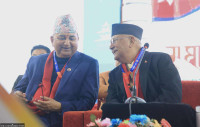Opinion
No highway in the sky
If Nijgadh is to ease TIA’s traffic bottleneck, the Fast Track road has to be prioritised
Sophia K Tamot
Month after month, week after week and almost everyday, our international airport resembles a terribly crowded, dirty, noisy, and poorly managed bus station. Not surprising, considering it is consistently rated as one of the worst 10 airports in the world.
If nature is to show its gloom such as a brief thunderstorm—which we see more and more of these days thanks to unpredictable changing weather patterns—an ensuing backlog of flights creates a traffic jam in the skies and planes circle for hours, queuing up for their turn to land. When the airplanes finally manage to touch down, relieved passengers are dismayed to discover the chaos that awaits them at the baggage retrieval area.
Computer screens do not accurately display which conveyer belt carries which flight’s passenger cargo. Officers in charge are either clueless, careless, or both. So what follows is a mad scramble to grab what few trolleys that are left as you navigate your way through heaps of unattended baggage that lay on the floor and you visit each belt to inspect the tags hanging on individual bags to verify if they belong to your flight. It is every man for himself.
Meanwhile, we continue to witness that in the world around us, including our immediate neighbouring countries, governments are either improving or expanding their airports, amenities, and infrastructure in general. But we are seriously lagging behind and in fact, regressing when it comes to our one and only international airport. Why is it that year after year, we spend ages bickering and only end up agreeing to disagree? From federalism to citizenship, from models of project financing to which ministry gets what project.
Lessons unlearned
Surely, Nepal learnt a very big lesson just last month when Turkish Air crash-landed on its nose on the side of the runway and was stuck there for four days, paralysing all inbound and outbound airport traffic. In less than 24 hours of the accident, politicians, policymakers, planners, and pundits all hurriedly revived talks about an urgent need to create a parallel airport—the only viable option was the Second International Aiport in Nijgadh that has been up and down the news wave for a few years now, floating among the tides like a limp lifejacket that has lost its bearer. However, the project now seems to have sprung back to life.
The truth is, Nepal needed to act yesterday, and take decisions based on sound and detailed planning—technical, economic and financial analysis—ideally years before Tribhuvan International Airport (TIA) reaches saturation point, which experts believe, even with all the planned upgrades, is less than six years away.
Instead, one fine day, we are faced with an event that we cannot just sweep under the carpet, and that is when we suddenly sit upright and try and make prompt decisions. Nijgadh airport is then declared the solution to TIA’s problems and the government announces its decision to demarcate construction boundaries for the airport. The private sector responds with glee. But then it begs some very basic questions—how is the project actually going to move forward? What is the funding mechanism? Who is going to build it?
There are currently plans to extend TIA’s runway, construct a new parallel taxiway, an international apron, and hangars—but construction is also likely to spill over to 2017. So if we are to gauge by the rate TIA has been moving, it is likely that the airport will continue to experience serious congestion in the years to come, and completely impair its ability to deliver quality service and even raise security concerns.
We needn’t look very far to see how well airports run by private operators function and are equally profitable to economies. There are several Public-Private Partnership models in major cities in India that have relied on the development of non-aeronautical revenue opportunities, which our TIA has not been able to leverage at all.
Today, service in TIA is already dismally poor. With increasing growth in air traffic, fueled by the outflow of remittance workers and inbound tourists, mounting passenger flow is inevitable. As major contributors to the GDP—a whopping 33 percent—don’t the migrant workers deserve to be treated as ‘commercially important persons’, instead of reserving a new wing catering to a select few?
What needs to be done
The proposed parallel airport at Nijgadh, as a greenfield project, presents tremendous advantages. Nepal will have the opportunity to build a world-class airport infrastructure, reduce TIA’s traffic, encourage large-volume cargo business, and develop Nijgadh as an aero-city. But to turn this possibility into a reality, there are certain preconditions. Number one is the Fast Track road that connects Kathmandu to Nijgadh and aims to cut eight hours of travel time to barely under an hour. Number Two is that the operator of the Nijgadh airport and TIA should be the one and the same—managing and operating it in an integrated manner will ensure efficiency and cohesiveness.
The bottom line is that if Nepal is truly serious about addressing the TIA traffic bottleneck via the Nijgadh airport, the Fast Track road has to be prioritised and literally fast tracked, including reviewing and revising its alignment to match the Detailed Project Design. Without this road, which is a lifeline to Nijgadh’s viability, investing further in the Second International Airport, will be like chasing a dream, one far more distant than Melamchi.




 10.12°C Kathmandu
10.12°C Kathmandu










